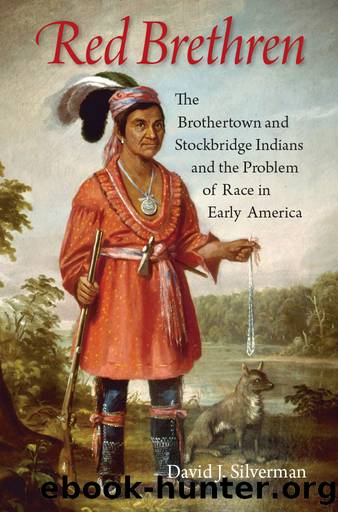Red Brethren by David J. Silverman

Author:David J. Silverman [Silverman, David J.]
Language: eng
Format: epub
Tags: History, Indigenous Peoples of the Americas, Social Science, Ethnic Studies, American, Native American Studies, Religion, Ethnic & Tribal, Americas (North; Central; South; West Indies)
ISBN: 9781501704796
Google: W0qGCwAAQBAJ
Publisher: Cornell University Press
Published: 2016-06-21T22:26:05+00:00
âWo, Wo, Woâ
From the very start, the Christian Indians had seen their communities as fragile experiments. The Oneidas recruited Kirkland back to his missionary post after the Revolution with the promise that they would make âone trial moreâ of Christianity and that âif there be no encouragement after this that we shall be built up as a people and embrace the religion of jesus he may leave us & we shall expect nothing but ruin.â47 A group of Montauketts visiting Brothertown in the spring of 1790 thought similarly. They told Kirkland that âtheir whole Nation have it in contemplation to move up into this wildernessâ because they saw âa probability that God may build up their Nation.â They admitted being âafraid Indians would not work like white people,â but âthey farther observed that if they thought they could all be united with regard to religion, they would move up and make one eff ort to live like white people, and leave the issue with that God who governed all the Nations of the Earth.â48 The Indiansâ assumption was that God rewarded his faithful and punished his enemies in the here and now, not only in the afterlife. The question that plagued Indians in the 1790s was how to account for whites becoming âstrong & greatâ through their low avarice and Indians degenerating into ânothing but a wreck of bonesâ despite their Christian efforts.49
Most Indians agreed that the root cause of their troubles was whitesâ greedy scheming, something they attributed to whitesâ basic character. âIndians have been so often deceived by white people,â observed Timothy Pickering after several visits to Oneida country, âthat White Man is, among many of them, but another name for Liar.â50 This opinion was so widespread as to be shared by the Oneidasâ Pagan Peter (as he was called with no hint of irony), leader of that tribeâs Nativist faction, and Samson Occom. Pagan Peter railed that âThe White skin race as a body have become proud. And some of you too proud. You glory in your riches, your great & commodious houses, your large fields & your abundance. You wear a white shirt & sometimes it is ruffled. And you despise us Indians for our indigence, our poor huts, our scanty food, & our dirty shirts.â Whites touted themselves as Christians, but Pagan Peter found them to be anything but Christ-like. âBrother Whiteskin Man,â he asked rhetorically, âdo you think that God our Maker . . . will make such a discrimination by & by or in the end. . . . A foul spirit may be concealed in a body richly clothed & a pure heart may reside unseen in another covered only in rags. God our maker will judge right in respect to the worth of souls, whatever complexion the bodies wear.â51 His words were barely distinguishable from Occomâs, whose sermons after the Revolution shifted from the themes of universal Christian fellowship and the need for Indians to reform to a critique of whites in which Indians were the Christian standard bearers.
Download
This site does not store any files on its server. We only index and link to content provided by other sites. Please contact the content providers to delete copyright contents if any and email us, we'll remove relevant links or contents immediately.
| Baha'i | Cults |
| Demonology & Satanism | Eckankar |
| Egyptian Book of the Dead | Freemasonry |
| Messianic Judaism | Mysticism |
| Scientology | Theism |
| Tribal & Ethnic | Unitarian Universalism |
The Four Agreements by Don Miguel Ruiz(6552)
Breaking Free by Rachel Jeffs(4121)
The Hatha Yoga Pradipika (Translated) by Svatmarama(3189)
120 Days of Sodom by Marquis de Sade(3125)
Member of the Family by Dianne Lake(2284)
The Tao of Physics by Fritjof Capra(2209)
The Psychedelic Gospels: The Secret History of Hallucinogens in Christianity by Jerry B. Brown(2097)
The Road to Jonestown by Jeff Guinn(2002)
Going Clear: Scientology, Hollywood, and the Prison of Belief by Lawrence Wright(1912)
Going Clear by Lawrence Wright(1897)
Uriel's Machine by Christopher Knight(1846)
The Grand Grimoire: The Red Dragon by Author Unknown(1739)
The Gnostic Gospel of St. Thomas by Tau Malachi(1715)
Key to the Sacred Pattern: The Untold Story of Rennes-le-Chateau by Henry Lincoln(1577)
The Malloreon: Book 02 - King of the Murgos by David Eddings(1536)
Waco by David Thibodeau & Leon Whiteson & Aviva Layton(1511)
The New World Order Book by Nick Redfern(1509)
The Secret of the Temple by John Michael Greer(1446)
Animal Speak by Ted Andrews(1428)
